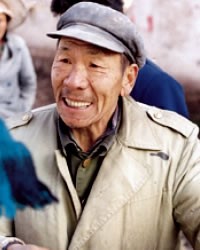Han Chinese, Min Nan in Taiwan

Photo Source:
Asia Harvest-Operation Myanmar
|
Send Joshua Project a map of this people group.
|
| People Name: | Han Chinese, Min Nan |
| Country: | Taiwan |
| 10/40 Window: | Yes |
| Population: | 12,957,000 |
| World Population: | 43,504,500 |
| Primary Language: | Chinese, Min Nan |
| Primary Religion: | Ethnic Religions |
| Christian Adherents: | 4.00 % |
| Evangelicals: | 3.70 % |
| Scripture: | Complete Bible |
| Ministry Resources: | Yes |
| Jesus Film: | Yes |
| Audio Recordings: | Yes |
| People Cluster: | Chinese |
| Affinity Bloc: | East Asian Peoples |
| Progress Level: |
|
Introduction / History
Min Nan speakers are among the Han Chinese, the largest ethnic group worldwide. They are the majority in China. The Min Nan language is also called Hokkien. It is primarily spoken along China's eastern and southern coasts, Hong Kong, Thailand, and especially in Taiwan where they make up over half the population. Their language came from a tenth-century kingdom based in Fujian, now a province of China.
Around 1600 the Yuan Dynasty ruled in China. Quanzhou, in today's Fujian Province, became a busy port city. People from that region emigrated to trade in other lands, including Taiwan. They brought the Hokkien language which changed over the last 500 years in Taiwan. In a couple of decades, there was the political chaos that came with the Ming Dynasty, and pirate merchants gained much power. This drove more people from Hokkien to migrate to Taiwan and other places. Though many Min Nan speakers arrived in the 1600s, far more came to Taiwan during the Qing Dynasty. The 1800s brought even more, but there was a flood of two million who came to Taiwan after the establishment of the People's Republic of China.
What Are Their Lives Like?
In Taiwan, the Min Nan Chinese have maintained their culture and language. They retain Chinese customs regarding marriage and family. They treat their children affectionately and usually indulge boys more than girls. The children are pushed to do well in school and are given much time to devote to their studies.
The Han Chinese are known for their politeness and will go to great lengths to avoid disputes. However, once a dispute begins it is very difficult to stop because the Chinese place a high value on "saving face." Giving ground in an open dispute would cause them to lose face—something the Min Nan Chinese try to avoid at all costs.
What Are Their Beliefs?
Most Min Nan Chinese have generally maintained traditional Chinese religion. Over time these traditional religious beliefs added elements of Buddhism, Confucianism and Taoism. These beliefs are centered around the concept of maintaining harmony, something greatly valued by all Chinese people.
The Min Nam Chinese consult horoscopes in an attempt to determine what course of action will promote harmony and bring good luck. They also believe in a pantheon of spirits who inhabit the earth. The spirits of their ancestors supposedly roam the earth, and if treated properly they will bring good luck. Ghosts are the spirits of people who are angry at the circumstances of their death; they are malicious and capricious. By contrast, deities are the souls of people who lived virtuous lives. They have spiritual powers that can be used to benefit those who worship them. Although the Min Nam Chinese claim adherence to these beliefs, they seem to have little effect on their everyday lives. Many are non-religious in their daily practices.
There is a small percentage of Christians among Min Nan speakers. Most of these are strong in their faith. They can be used by God to disciple many.
What Are Their Needs?
Like people everywhere, the Min Nan people need to put all their hope and faith in Jesus Christ. Only then will they have life to the full that only Jesus offers.
Prayer Points
Pray for Min Nan people to be Christ's ambassadors of Christ in Taiwan.
Pray for Min Nan workers, filled with the fruit of the Holy Spirit, to disciple others.
Pray for Min Nan speakers to begin a family-based movement to Christ that will bless them abundantly.